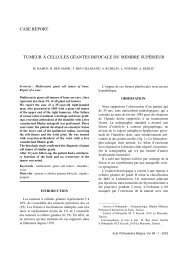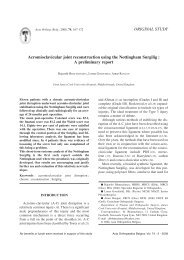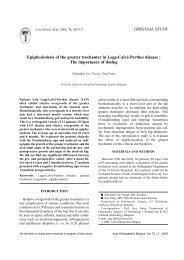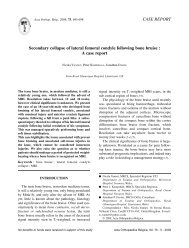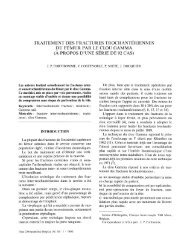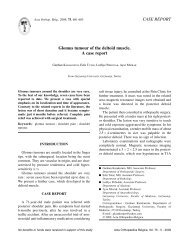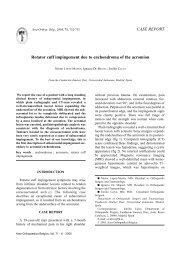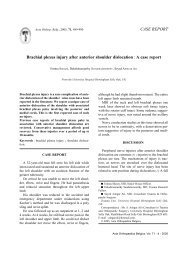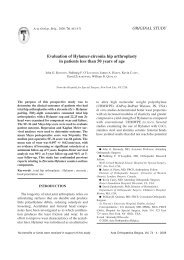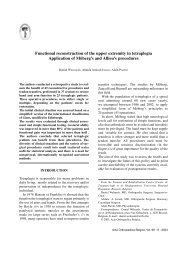Modified Essex-Lopresti / Westheus reduction for d... - ResearchGate
Modified Essex-Lopresti / Westheus reduction for d... - ResearchGate
Modified Essex-Lopresti / Westheus reduction for d... - ResearchGate
- No tags were found...
Create successful ePaper yourself
Turn your PDF publications into a flip-book with our unique Google optimized e-Paper software.
86 A. PILLAI, P. BASAPPA, S. EHRENDORFERapplied to the talus by lifting the leg off the operatingtable with the knee flexed, and manoeuvringthe fragment with a Gissane os calcis spike (6). The<strong>reduction</strong> is held by incorporating the spike in aplaster cast. Modifications of the original techniquehave been reported with the patient supine and alsoin the lateral positions (13).There are several advantages to the technique wepropose :1) Supine position of the patient. Patients with calcanealfractures may indeed have other associatedinjuries, the most common being fracturesof the spine and the pelvis. In such patientsachieving a prone or even lateral position maybe difficult.2) The figure of four- position makes imaging witha modern C-arm easy. If a radiolucent table isnot available, then the foot can be simplybrought over the edge of the table, or even madeto rest on the C arm itself.3) Traction is applied by means of a pin passedproximal to the os calcis, and no leverage isapplied to the intraosseous pin. This may preventloosening and pin site infection.4) The technique allows the axial pin to be introducedby power under image guidance.5) Advancing the pin into the cuboid, providesadditional stability to the fixation.6) The technique is suitable <strong>for</strong> use with cannulatedcancellous screws.Bohler’s tuber joint angle is commonly assessedwhen evaluating calcaneal fractures. A severe heelfracture will result in significant decrease or loss ofthe angle. A number of studies clearly indicate thatBöhler’s angle is a good predictor of long termfunctional outcome in calcaneal fractures (4, 5, 15).Patients with angles less than 15 degrees did significantlyworse than those with greater angles.This was the reason <strong>for</strong> choosing Böhler’s angle asthe measure of surgical <strong>reduction</strong> in our patients. Inour group of patients, a mean correction of10.5 degrees was achieved in the JD group and19 degrees in the TS group. A mean post operativeBöhler angle of greater than 15 degrees wasachieved in both groups of patients. The plain radiographfracture classification by <strong>Essex</strong>-<strong>Lopresti</strong>based on the configuration of the secondary fractureline through the posterior facet, as used in ourstudy was also found to be highly prognostic (p =0.035) (4, 5).Compared to open procedures, percutaneous<strong>reduction</strong> and fixation offers lower complicationrates, shorter operating times and more rapid healingdue to the undisturbed soft tissue envelope (1, 8,11). For carefully selected patients, this techniqueprovides good results comparable with open <strong>reduction</strong>and internal fixation. Ten out of 15 patients inour series were either smokers or diabetics, whowould be considered high risk <strong>for</strong> open <strong>reduction</strong>and internal fixation (4, 5). The overall infection ratein our series is only 6%, and we did not encounterany additional complications in this vulnerablegroup.Eighty percent (12 patients) of our patients weremale and 40% (6 patients) were involved in heavymanual work. Both factors are considered to lead topoor outcomes after open fixation.The scope of percutaneous techniques <strong>for</strong> thetreatment of intra-articular fractures of the calcaneusis limited. The goals of this approach are toimprove the alignment of the calcaneus and <strong>reduction</strong>of the posterior facet. In tongue-shaped fractures,the posterior articular facet is contiguouswith the posterior tuberosity. Direct manipulationof the facet is possible by traction and a pin insertedinto the posterior tuberosity. This allows thefracture to be reduced accurately percutaneously(10). In joint depression type, the posterior articularfacet is depressed, rotated and often impactedinto the posterior body fragment. Since directmanipulation of the facet is not possible, by a pininserted into the posterior body fragment, itbecomes difficult to achieve an accurate <strong>reduction</strong>by this technique (10). Our results thus support earlierobservations that the percutaneous technique isbest suited <strong>for</strong> tongue shaped fractures (22, 23). Themean correction achieved as well as the mean overallfunctional scores were significantly better inthis group. However, our results clearly show that acorrection of the Böhler angle was achieved in bothtongue shaped and joint depression types of fracturesby the technique described. The addition of asecond traction pin allows greater <strong>for</strong>ces to beActa Orthopædica Belgica, Vol. 73 - 1 - 2007



